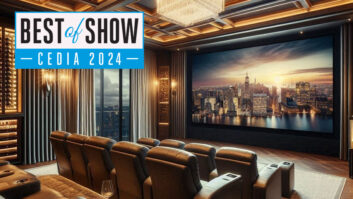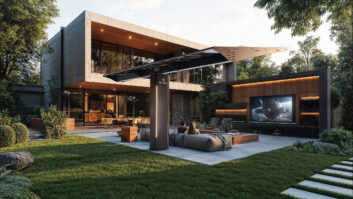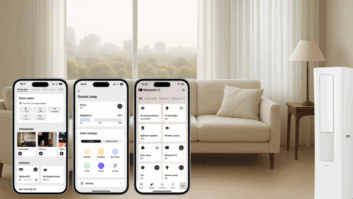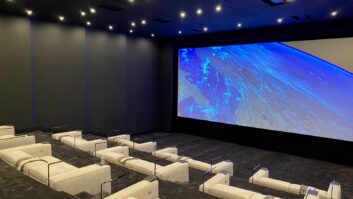In the prehistoric days of home theater, mammoth three-gun CRT projectors stood solidly at the center of the residential A/V universe. Everything revolved around this hulking mass of metal and light, including clients’ budgets. After making the costly commitment to what was then the only viable option in reproducing film-quality content at home, customers found themselves with scant resources to add quality audio and control equipment to their order.
This scenario had limitations beyond just systems design. The price barrier to entry in home theater was so high it kept the market small, and worse yet, once the upper echelon of customers had a projector installed, the market started tapering off. Then, the CRT projector looked like it was doomed to the endangered species list when components became scarce.
Fortunately, as every industry began to evolve with digital technology in the late 1990s, home theater also made the leap into a new, more efficient form factor. With the further development of Texas Instruments’ DLP technology, suddenly projectors didn’t have to be such a large part of the layout or the budget of a home theater. Making this evolutionary step while preventing the extinction of the CRT, has been the crowning achievement at SIM2 Multimedia, where a line of DLP home theater projectors peacefully coexists with their CRT ancestors.
“DLP technology has allowed us to branch out into different consumer channels,” said SIM2 Sleco USA vice president, Dan Drook. “We were growing in our CRT market, but DLP has allowed us to grow at a more expedited rate.”
With several new projector formats on the horizon at the end of the last millennium, most people knew a revolution in home theater projection was coming, but few people knew which technology would take the lead. Predicting just which digital solution would provide the most accurate color reproduction and the most elegant solution to product design would take a serious commitment to research and development, and more importantly, a vast amount of experience in the technology that had brought the home theater market to where it stood. In the pivotal year of 1999, the Italian parent company of CRT kingpin Sleco identified the U.S. as the center of the home theater market, and to better focus on product development for this category, it strategically acquired its U.S. distributor in Miramar, Florida. Hence renamed as SIM2 Sleco USA Inc., the company began its role in ushering in the DLP revolution.
Perhaps “evolution” might be a better term for SIM2’s involvement with DLP, as the company saw the technology’s possibility in its R&D crystal ball years ahead of its first product launch for the residential market.
“If you have your eyes on the road, you don’t have to reinvent,” Drook said. “If you monitor constantly, you just make fine tuning adjustments.”
SIM2’s design philosophy has its roots in the belief that constant innovation will lead not only to better new products, but also better performing legacy products which benefit from software upgrades as the company continually revisits the technology that drives its projectors.
“In the past everyone was shooting at the same technology, the same way of resolving issues,” Drook said. “What we’re able to do, because we manufacture the product, is constantly look for ways to improve it.”
With headquarters in Pordenone, Italy, SIM2’s parent company, the Formenti Sleco Group, is Italy’s largest manufacturer of consumer electronics. Coming from this background, where industrial design takes precedence, SIM2 Multimedia invests over 20 percent of its human resources and over 8 percent of total turnover in R&D activities, assuring a constant innovation of products.
A steady progression of evolutionary steps have built SIM2’s Grand Cinema line of DLP projectors, the first one of which launched in 2000. The Grand Cinema idea was born after SIM2 spent a couple of years developing products with three-chip DLP technology. These experiments led the company to decide to invest its financial and human resources in the design of a revolutionary single-chip DLP-based projector dedicated to the home theater market.
Leading the charge in taking the company into the home theater market was Drook, who helped translate SIM2’s Italian design expertise into a viable American enterprise. “Knowing what would be available from Texas Instruments and working closely with them, the Grand Cinema line was developed,” Drook explained. Since the start, the Grand Cinema line’s roster of products has been perfectly synchronized with each of TI’s improvements to DLP technology. First, the HT200 was brought to market based on the basic 4:3 DLP chip. Then, following the progression from TI, the HT250 was introduced, which used the 1024 x 768 chip.
“With TI’s development, we then saw the opportunity then to launch what was called the HT200DM (dual mode) projector, which does 800 x 600 and 1024 x 768,” Drook said. “All this time we knew ultimately what our dealers and consumers were looking for because of talk about the technology coming out, which was a true 16:9 resolution chip, which brought us the HT300.” The first HT300 relied on the HD1 chip, but at CEDIA EXPO 2002, SIM2 launched the HT300 Plus, which maximizes the potential of the HD2 chip from TI.
The HT300 fully benefits from SIM2’s R&D efforts over the years. A proprietary optical engine design and sealed optical path maximize the brightness and color saturation of video which is projected by a long-throw-ratio zoom lens. Further changing the way home theaters are designed in the post-CRT era, this long-throw ability and digital keystone correction allow the HT300 to be placed at the back or even the side of a room, up and out of the way of those who are enjoying a film.
In additional to including a wide selection of inputs to enable the HT300’s connection to all video and PC devices, SIM2 has also designed a unique accessory, the Remote Input Interface (RII), which connects all video sources to the projector through a single cable, eliminating multiple cable runs.
In defining these aspects of the HT300, SIM2 discovered ways in which the projector’s predecessors could benefit from the new developments. “The evolution is as important as the product,” Drook said. “The interesting thing about the Grand Cinema line is that it’s all software upgradeable. If during the development the designers found something in the HT200 that they thought would be a benefit to any of the other models, it could be applied. Still today, as they’re constantly looking at ways to improve the 300, if there’s a software upgrade that applies to any of the other models that would improve the picture or performance, it can be downloaded and applied to those projectors”.
All of SIM2’s dealers and reps have been trained in how to download projector upgrades from an exclusive tech support website, where PDFs of manuals and a throw-ratio calculator are also provided for improving the installation process. This keeps the product evolution going even after the projector has been installed.
“After what’s happened with computers, consumers worry about the technology being outdated as soon as they buy it,” Drook said. “In this case you’re getting the benefits of the improvements as they become available.”
The mechanical aspects of the Grand Cinema line of projectors are subject to the same progressive improvements. In the company’s test facilities, R&D engineers conduct experiments with the various segments of the color wheel in order to determine what size produces the best output.
“We develop the color wheels and they’re built to our specifications,” Drook explained. “Our engineers don’t lose control of any aspect of the product.”
As a company that definitely doesn’t fear the concept of “heading back to the drawing boards,” SIM2 Multimedia has found yet another way to implement DLP technology in its line of residential products. Also new at CEDIA this year was the Grand Cinema RTX rear-projection monitor, which is available in two sizes, 45 inches and 55 inches.
Kirsten Nelson is editor of Residential Systems sister publication, Systems Contractor News (www.systemscontractor.com).







